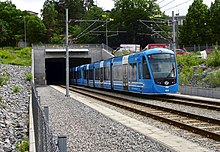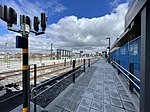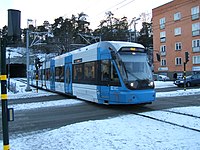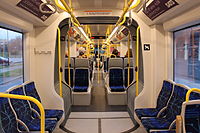Tvärbanan
You can help expand this article with text translated from the corresponding article in Swedish. (January 2020) Click [show] for important translation instructions.
|
| Tvärbanan | |||
|---|---|---|---|
 | |||
| Overview | |||
| Owner | Region Stockholm | ||
| Area served | Stockholm | ||
| Locale | Nacka, Solna, Stockholm, Sundbyberg | ||
| Transit type | Tram/Light rail | ||
| Number of lines | 2 | ||
| Line number | Line 30, Line 31 | ||
| Number of stations | 28 | ||
| Daily ridership | 98,000 (2018) | ||
| Headquarters | |||
| Website | SL | ||
| Operation | |||
| Began operation | 8 January 2000:
(Gullmarsplan–Liljeholmen) 1 June 2000: (Liljeholmen–Alvik) 8 February 2002: (Gullmarsplan–Sickla udde) 10 April 2013: (Alvik–Solna centrum) 8 June 2014: (Solna centrum–Solna station) 10 February 2017: (Sickla udde–Sickla station) 5 April 2021: (Norra Ulvsunda–Bromma flygplats) | ||
| Operator(s) | VR Group | ||
| Character | At-grade, elevated, in tunnels, street running | ||
| Technical | |||
| System length | 20 km (12 mi) | ||
| No. of tracks | 2 | ||
| Track gauge | 1,435 mm (4 ft 8+1⁄2 in) standard gauge | ||
| Electrification | 750 V DC OHLE | ||
| |||
Tvärbanan is a light-rail line in Stockholm, Sweden. Its name translates literally to The transverse line, as it operates crosswise to the otherwise radial metro and commuter rail lines of Stockholm. It links together several transit lines through its connections with the southern, western and northern subway branches of the Stockholm Metro (Tunnelbana) as well as three branches of the Stockholm commuter rail (Pendeltåg). The possibility to travel between southern, western and northern greater Stockholm without having to enter the city centre significantly reduces the number of transit passengers, also reducing the number of trains having to pass through the Old Town bottleneck during peak hours. Near Liljeholmen the track is shared with freight traffic for a short section, this being the only place in Sweden where freight traffic and trams share the same track.
The tramway is separated from roads in most parts, but there are sections in Gröndal, Sundbyberg and Solna where the tracks run on roads among regular road traffic. In Hammarby sjöstad the trams run in a reservation in the centre of the road rather than in mixed traffic, but there are several level crossings.
Traffic on Tvärbanan started in 2000, first between Gullmarsplan and Liljeholmen, then later between Liljeholmen and Alvik, in 2002 between Gullmarsplan and Sickla Udde, and in 2013 between Alvik and Solna centrum. It has later been extended to Solna Station (2014), Sickla (2017) and most recently, Bromma Airport (2021), the last of which being the first part of the new Kista branch. Tvärbanan was used by around 108,000 passengers per weekday in 2019.[1]
The bridges used by Tvärbanan include Alviksbron, Gröndalsbron, Fredriksdalsbron and Ulvsundabron.
History[edit]
During the latter part of the 1980s, interest in tramway transportation grew in the Stockholm area, with various proposals emerging from both public and private sectors. One notable group, dubbed the "Tvärspårvägsgruppen" (Cross-tramway Group), comprising Asea, Skanska, VBB, and the transport consultancy firm Transek, along with PKbanken and Skandinaviska Enskilda Banken, presented conceptual studies for tramway networks in Stockholm's northern and southern suburban regions.[2] The proposed northern cross-tramway would run from Vällingby to Mörby via Hässelby, Barkarby, Akalla, and Häggvik, while the southern cross-tramway would connect Skärholmen and Skarpnäck via Huddinge and Farsta. Additionally, the "Hästskolinjen" (Horseshoe Line) was suggested in the Semi-central Belt, linking Hammarby Sjöstad to Ropsten, passing through Liljeholmen, Alvik, and Karolinska Hospital.[3]
Stockholm County Council conducted a tramway investigation, prioritising the "Horseshoe Line" as the most economically viable route. However, during the planning phase, negotiations for the "Dennis package" an agreement for investments in rail and road infrastructure in Stockholm County,[4] occurred simultaneously with regional infrastructure planning. The agreement reached in September 1992 only included the Horseshoe Line, now referred to as the "Snabbspårvägen" (Express Tramway). Consequently, it was incorporated into the regional plan of 1991, with land reserved in the Stockholm comprehensive plan for the line.[5][6]
Construction of the Tvärbanan (Cross Tramway) began in 1996, with the segment between Gullmarsplan and Liljeholmen opening for traffic in January 2000, followed by an extension to Alvik later that year. This extension marked the first new North-South connection across lake Mälaren or the Baltic Sea in Stockholm in approximately 40 years. Another extension from Gullmarsplan to Sickla Udde in Hammarby Sjöstad opened in August 2002, facilitating efficient interchange with suburban trains from the south upon the opening of the Årstaberg station in January 2006.[7]
The initial funding covered the Alvik-Gullmarsplan section, but financing for subsequent segments was anticipated to be resolved by 1996. However, no funding solution materialised, and the agreement dissolved in February 1997. Despite this setback, construction progressed, and in 2009, the expansion of Tvärbanan's Solna Branch commenced. This new section from Alvik to Solna Centrum opened in 2013, with the final stretch to Solna Station completed in August 2014.
Critics highlighted the high costs and technical standards of the Alvik-Solna section, which exceeded initial estimates. Nevertheless, the Tvärbanan's positive impact on commuting, especially in areas like Hammarby Sjöstad and Årstadal, led to increased frequency being required, improving from a 10-minute to a 7.5-minute service during peak hours.
From 2013 to 2017, the Tvärbanan operated as two separate lines, both designated as Line 22, with interchange available at Alvik. However the original signalling system was replaced between Sickla Udde and Alvik in 2017, with entire line reopening in August 2017 for through-traffic at Alvik. The first section Kista branch, connecting Norra Ulvsunda to Bromma Airport, commenced operations in May 2021 as Line 31, with a further extension to Kista and Helenelund currently under construction.[8]
Lines[edit]
Tvärbanan has two lines (30 and 31). L30 with 26 stops, going from Sickla south of the Stockholm city centre through Gullmarsplan, Årsta, Liljeholmen, Gröndal, Stora Essingen, Alvik west of the city centre, and Sundbyberg to Solna. The part to Solna Centrum opened 28 October 2013, and the final part to Solna Station opened 18 August 2014.[9] The Friends Arena can be reached within 15 minutes' walk from there. A single-stop extension from Sickla udde to Sickla opened on 2 October 2017, allowing for transfers with the Saltsjöbanan.[10]
L31 has only 6 stops, going from the station of Alviks strand, passing through Alvik allowing for transfers to the Green line and Nockebybanan, until continuing to Bromma Flygplats. The line opened on 16 May 2021 and is planned to be extended further in the near future, with construction underway. The line runs on the same track as line 30 except for the branch to Bromma Airport itself. The nearby Bromma Blocks shopping centre is served with a new stop as well.
| Line | Stretch | Length | Stops |
|---|---|---|---|
| 30 | Solna Station – Sickla | 18.2 km (11.3 mi) | 26 |
| 31 | Bromma airport – Alviks strand | 4.1 km (2.5 mi) | 6 |
Main interchange options[edit]
- Solna Station
- Commuter rail lines 40, 41, 42
- Solna centrum
- Metro blue line 11
- Sundbybergs centrum
- Metro blue line 10
- Commuter rail lines 43, 44
- Alvik
- Metro green lines 17, 18 and 19
- Nockebybanan (light rail line 12)
- Liljeholmen
- Metro red lines 13 and 14
- Årstaberg
- Commuter rail lines 40, 41, 42, 43 and 44
- Gullmarsplan
- Sickla
- Saltsjöbanan (suburban rail line 25)
Rolling stock[edit]
Tvärbanan is served by tram types designated A32 and A35. The A32, Flexity Swift from Bombardier, began operating the Tvärbanan with the start in 1999. The A35, Urbos AXL from CAF was introduced in connection with the extension to Solna in October 2013.[11] Both types are approximately 30 meters long and have 72–78 seats each,with two trams usually coupled to increase capacity, leading to a train of around 60 meters long.[12][13] This compares to the 140 meter metro trains and the 214 meter commuter trains.
The trams are manned by a driver. Until June 2016, there was also a conductor on board for ticket validation. These are today replaced with ticket validators located at all stops.
Signalling system[edit]
A signalling system monitors and controls the movements of rolling stock on a rail network to ensure safe operation. Tvärbanan previously suffered from a long-standing issue of incompatible and low performing rail signalling systems. The Tvärbanan network featured multiple different signalling systems from different vendors, because when the rail line was built, the signalling systems were tendered separately for each construction stage. A visible example of this was at the Alvik station, which was a break point between two systems. Even though the line runs straight at Alvik, the same train could not be run past the station because of the incompatibility of the systems. Passengers had to switch trains there. The section south of Alvik was closed during the summer of 2017 to upgrade the signalling.[14]
Extension[edit]
Construction on a branch line to Kista and Helenelund started in February 2018.[15] The new branch was scheduled to open its first part to Bromma Airport in December 2020,[16] however this was postponed, as approval from Swedavia was needed in order for the trams to be able to run past the airport.[17] In cold weather, sparks arise from the trams' overhead contact line, which could disrupt radio signals in the air traffic control tower at Bromma Airport. Tests needed to be carried out in sub-zero temperatures to gain approval for traffic.[18]
The first part of the new branch opened on 17 May 2021, with trams running on Line 31 between Alviks strand and Bromma flygplats.[19]
New Stops[edit]
Bromma Blocks[edit]
Bromma flygplats[edit]
Gallery[edit]
-
Årstadal
-
Tunnel Near Alvik
-
Tram Near Traneberg Tunnel
-
Tram Arriving at Alvik
-
CAF A35 Interior
-
Stora Essingen
-
Tram Near Traneberg Tunnel
-
Johannesfred
-
Tram Near Liljeholmen
-
Globen
Detailed map[edit]
See also[edit]
References[edit]
- ^ "Fakta om SL och regionen 2019" (PDF) (in Swedish). Storstockholms Lokaltrafik. p. 34. Archived (PDF) from the original on 27 December 2020. Retrieved 3 April 2021.
- ^ Ranhagen, Ulf (1988). "Tvärspårväg norr Stockholm : VBB arkitekter och VBB trafik". Arkitektur: byggnad, interiör, plan, landskap (3): 10–11.
- ^ ”Utlåtande 1990:167 RIX”. Stockholms kommun. maj 1990. sid. 3336. Läst 20 oktober 2020.
- ^ "Stockholm: The Tale of the Unicorn Factory". European Investment Bank. Retrieved 18 February 2024.
- ^ Det regionala arvet. Stockholms läns landsting, Regionplane- och trafikkontoret. 1996. sid. 42. ISBN 9186574-48-5
- ^ ”Utlåtande 1990:167 RIX”. Stockholms kommun. maj 1990. sid. 3336. Läst 20 oktober 2020.
- ^ "Tvärbanan och Nockebybanan |". lokstallet.n.nu. Retrieved 18 February 2024.
- ^ "Tvärbanan till Helenelund - Stockholms stad". vaxer.stockholm (in Swedish). 15 February 2024. Retrieved 18 February 2024.
- ^ "Påminnelse: Pressinbjudan till invigning av Tvärbanan till Solna station". Pressmeddelande. Retrieved 18 August 2014.
- ^ Barrow, Keith (2 October 2017). "Stockholm Tvärbanan reaches Sickla station". International Railway Journal. Retrieved 4 June 2020.
- ^ "Lokman.se | Tvärbanan". www.lokman.se. Retrieved 18 February 2024.
- ^ "SL A32 - Svenska Spårvägssällskapet". www.sparvagssallskapet.se. Retrieved 18 February 2024.
- ^ "SL A35 - Svenska Spårvägssällskapet". www.sparvagssallskapet.se. Retrieved 18 February 2024.
- ^ "Nytt signalsystem sinkar Tvärbanan". 3 March 2014.
- ^ Claesson, Frida (19 February 2018). "Första spadtaget för Tvärbanans nya Kistagren". SVT Nyheter (in Swedish). Retrieved 4 March 2018.
- ^ "Tvärbanan till Kista och Helenelund" (in Swedish). Stockholm County Council. Retrieved 15 May 2017.
- ^ "Bussar ersätter på nya spårvagnssträckan till Bromma flygplats | SL". sl.se. Retrieved 12 January 2021.
- ^ Radio, Sveriges (5 March 2021). "Tvärbanan kan störa på Bromma flygplats – oklart när tågen kan rulla - P4 Stockholm". Sveriges Radio (in Swedish). Retrieved 17 May 2021.
- ^ Claesson, Frida (16 May 2021). "Nya Tvärbanans första etapp klar – trafikerar Bromma flygplats". SVT Nyheter (in Swedish). Retrieved 17 May 2021.
External links[edit]
- Simplified line map - Official site (Swedish)
- Storstockholms Lokaltrafik (Stockholm Transport) - Official site (Swedish)
- Stockholm county's page about Tvärbanan - Official site (Swedish)

























